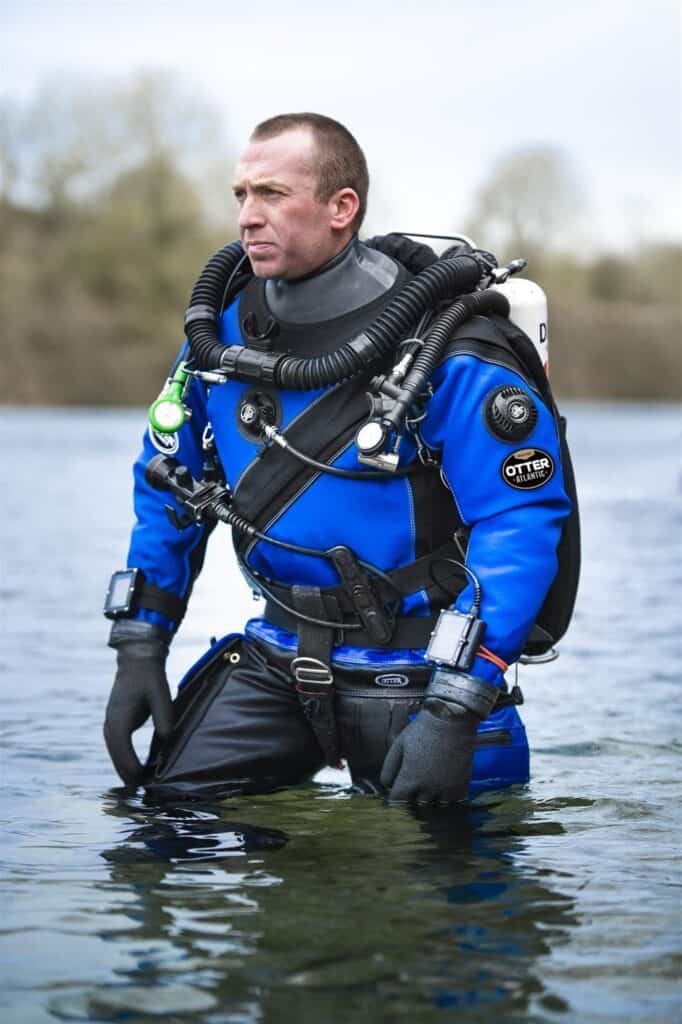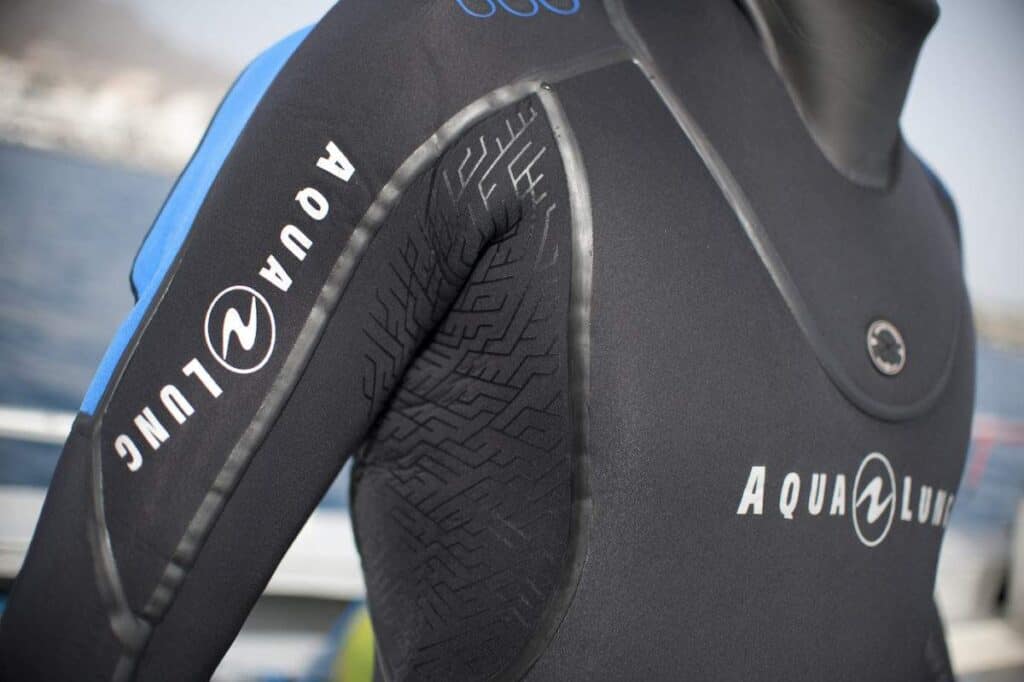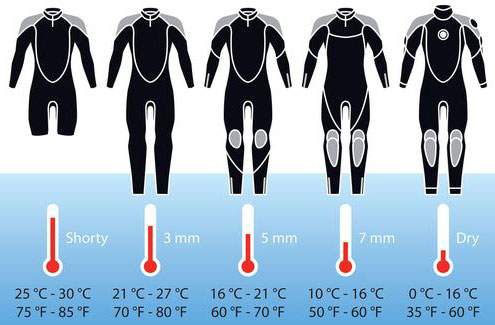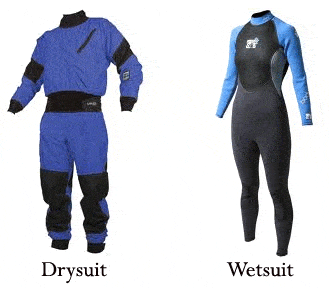Choosing the correct suit for a dive is essential. It can make the difference between a fun and enjoyable dive or a miserable one that needs to be ended early. The majority of dives only require a wetsuit but for specially trained divers, dry suits are also an option. The two main types of suits are either dry suits or wet suits. Within the wetsuit category is shorties which are shorts instead of full length.
The two main types of suits to wear while diving is dry suits and wetsuits. Drysuits are designed to keep you dry by using waterproof material and seals around the neck and wrists. These suits are used for very cold waters and divers need to be taught how to use them correctly. Wetsuits on the other hand allow water to penetrate the suit and trap it inside to insulate the diver. These suits can be used by all divers as there is no need to learn how to use them.

Drysuit
This type of suit keeps the body dry and unlike wetsuits, never allows water to enter the suit. The drysuit is not necessarily designed to keep the body warm while diving. Divers will need to use layers of garments under the suit to keep them warm. These suits are specifically meant to keep divers dry and offer them a layer of insulation. Diving with a drysuit is much different than using a wetsuit. Drysuits must be fitted correctly and divers need to practice using them. This is because drysuits alter buoyancy by using air to inflate the suit. The suit’s air levels need to be adjusted during a dive similar to the air levels in a BCD.
The air in a drysuit is regulated with the use of two valves. The inflation valve is usually located on the chest of the suit and is connected to a hose that inflates the suit using low pressure. Pressing down in the valve slowly inflates the suit. The deflation valve is normally located on the left shoulder of the suit. The diver needs to position their body so that the deflation valve is at the highest point. Then the diver just pressed down on the valve to release air. Most modern suits have the capability of deflating hands-free by raising the arm and shoulder to allow air to escape the suit through the valve.
Divers need to be trained and learn how to use drysuits because there is the element of air and buoyancy involved. A panicked diver may quickly rise to the surface accidentally skipping a safety stop. They must also learn how to adjust air levels of the suit during dives.
Fit
The fit of a drysuit is looser than traditional wetsuits. This is because drysuits are meant to be worn over other insulating garments. The number of garments worn under the suit depends on water temperatures and the cold tolerance of each diver. It’s best to have your suit fitted so that movement while diving is not restricted. All drysuits have watertight zippers and seals at the neck and wrists. In addition to this, drysuits have feet so that the suit is completely sealed and no water is able to get in.
Divers who wish to invest in a drysuit can have them customized including adding additional pockets placed where the diver wants.
When to Use
The best time to use a drysuit is in cold to very cold water temperatures. Water temperatures ranging from 35-60 degrees Fahrenheit (0-16 C). Since this style of suit keeps you dry there is less of a risk of hypothermia when diving in cold waters.

Wetsuit
A wetsuit keeps the body warm by trapping a thin layer of water in the suit and using it as in insulator. As your body warms that layer of water it helps to maintain regular and normal body temperature. Wetsuits are the primary form of insulation and protection used when diving. They are simple to use and unlike drysuits, require no knowledge or previous experience.
Fit
Wetsuits should fit tightly against the body and feel more like a second skin. They are usually a bit difficult to get on as you’ll need to work them up bit by bit. This is normal and definitely the most time-consuming aspect of gearing up. Once the user enters the water, this tight fit helps to preserve the layer of water used for insulation. For multiple dives try not to take your wetsuit completely off between dives. This is because it’s even harder to get on once wet.
The thickness of a wetsuit depends on the type of dive. Dives in colder and deeper water will require thicker suits. Generally speaking, wetsuits come in thicknesses ranging from 1-8mm (0.04-0.31 inches). Local dive shops will be able to direct you to the specific thickness according to the dive and location. Since most people just rent their gear, simply ask which thickness they recommend.

When to Use
Wetsuits are used on just about every dive. They offer protection, warmth, and are suitable for all levels of divers. You generally see full-length wetsuits used in water temperatures ranging from 60-75 degrees Fahrenheit (16-25 C). Since dives usually last from 30-45 minutes it’s quite common for divers to become cold even in 75-degree waters. Wearing a wetsuit even in warmer waters keep body temperatures normal and helps prevent hypothermia.
Shorty
A shorty is a type of wetsuit that is used in warmer water temperatures and on shallow dives. These are generally the best option when diving in waters ranging from 75-85 degrees Fahrenheit (25-30 C). They allow for protection and warmth but to a lesser degree than a full-length wetsuit. They are most commonly used in tropical waters and on shallow reef dives.
Since this is a type of wetsuit the fit should be tight and snug. The only variation with this style is that they allow the legs to be exposed and come in fewer thickness options.
Which Would You Choose?
Just about every diver begins with wetsuits. They are simple and require nothing but the proper size and thickness. Once a diver is comfortable with wetsuits and has a basic understanding of buoyancy they can then test out drysuits. Divers can get properly fitted, learn how to properly use them, and begin diving with drysuits. Most divers have never used a drysuit and it’s purely a matter of preference and type of dive.

